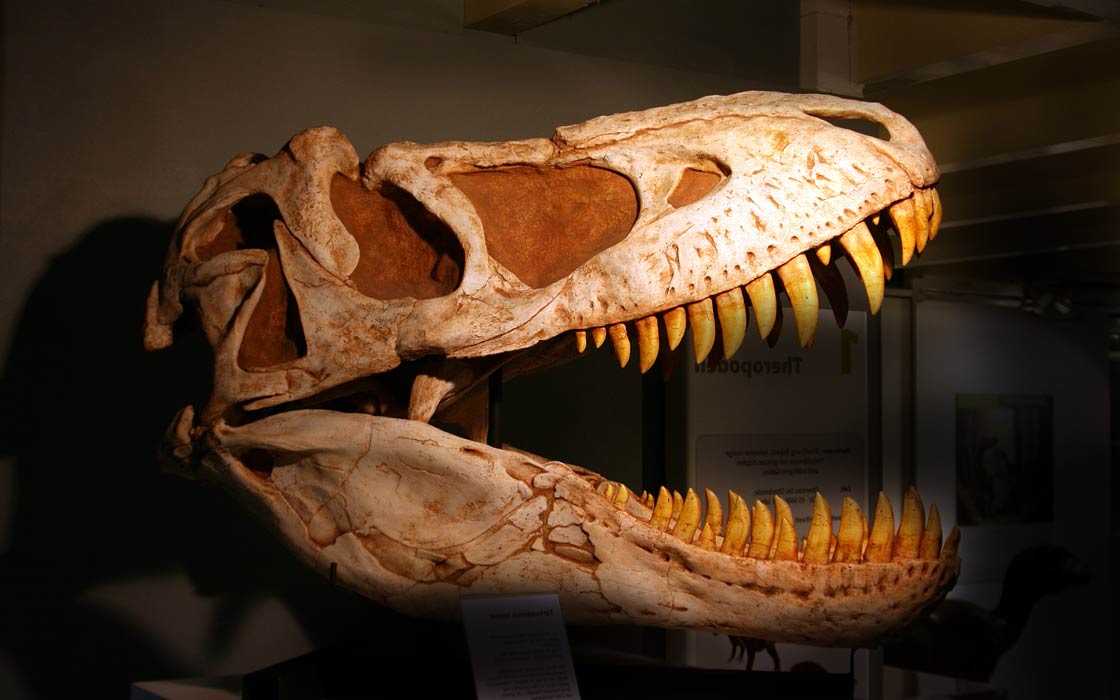Dinosaur: Tarbosaurus bataar

| Length*: | 10.6 m | 34.8 ft |
| Weight*: | 5.2 tons | 11,464 lb |
| Speed: | 36 km/h | 22 mph |
*The largest known specimen
Period
Epoch: Late Cretaceous
Stage: Early Maastrichtian
Years: 72.1–66 Ma
Details
Status: valid
Author: Rozhdestvensky
Year: 1965
Distribution
Area: Asia
Country: Mongolia, China
Region: Ömnögovi, Bayankhongor, Xinjiang, Henan
Formation: Nemegt, Subashi, Barun Goyot, Qiupa
Description
Tarbosaurus bataar
Tarbosaurus bataar was a large theropod dinosaur from the Late Cretaceous period, approximately 72–66 million years ago (Maastrichtian stage). Found in the Nemegt Formation of Mongolia, Tarbosaurus is closely related to Tyrannosaurus rex and is one of the largest predatory dinosaurs discovered in Asia. Its name Tarbosaurus means “alarming lizard,” and bataar is derived from a Mongolian word meaning “hero” or “warrior.” The discovery of Tarbosaurus in the 20th century helped to highlight the similarities and differences between Asian and North American tyrannosaurids.
Physical Characteristics
Tarbosaurus bataar was a large theropod, with adults reaching lengths of up to 10–11 meters (33–36 feet) and weighing between 4–5 metric tons (8,800–11,000 pounds). Its body was similar to that of Tyrannosaurus rex, with a large, heavy skull, powerful jaws, and sharp, serrated teeth, designed for crushing bone and tearing through flesh. The skull of Tarbosaurus was approximately 1.3 meters (4.3 feet) in length, slightly narrower than that of T. rex, with proportionally smaller eyes, suggesting different feeding and hunting strategies.
Its forelimbs were small, even compared to those of T. rex, with only two functional fingers on each hand. These arms were likely vestigial and played little role in predation. The hind limbs, however, were powerful and built for supporting the animal’s massive weight, with strong muscles indicating it was capable of walking long distances, but not built for high-speed pursuit.
Tarbosaurus had a long, heavy tail that provided balance, helping to counterbalance its massive head. Its teeth, around 60–64 in total, were large and conical, perfect for delivering crushing bites to immobilize its prey. Unlike Tyrannosaurus rex, Tarbosaurus had a more elongated skull and straighter, less robust teeth, which may reflect differences in prey types or hunting strategies.
Diet and Feeding Habits
As an apex predator, Tarbosaurus bataar was a carnivore that primarily preyed on large herbivorous dinosaurs like hadrosaurs and sauropods. Its powerful bite, combined with its bone-crushing teeth, allowed it to deliver fatal wounds to its prey. The robust jaws and teeth of Tarbosaurus suggest it was capable of processing large amounts of flesh and bone, similar to its North American relative T. rex.
Some paleontologists believe Tarbosaurus was more of a scavenger than an active predator due to its small forelimbs and the structure of its skull, which may have limited its ability to engage in high-speed chases. However, it likely played a dual role in its ecosystem, both hunting and scavenging depending on opportunity.
Habitat and Distribution
Tarbosaurus bataar lived in the Nemegt Basin of what is now the Gobi Desert in Mongolia. During the Late Cretaceous, this region was a rich, semi-arid environment with rivers, floodplains, and forests. The Nemegt Formation, where Tarbosaurus fossils are frequently found, preserves a variety of dinosaur species, including large herbivores like Saurolophus, Nemegtosaurus, and Therizinosaurus, which likely served as prey for Tarbosaurus.
The Nemegt Formation also contains evidence of abundant freshwater ecosystems, indicating that Tarbosaurus lived in a region with seasonal wet and dry periods. This environment would have supported a diverse ecosystem of plants and animals, with Tarbosaurus occupying the top of the food chain.
Behavior and Social Structure
While there is no direct evidence of social behavior in Tarbosaurus, it is possible that it exhibited similar behavior to other large theropods. Like Tyrannosaurus rex, Tarbosaurus may have been a solitary hunter, using its size and strength to take down prey. However, some paleontologists have speculated that tyrannosaurids may have exhibited pack hunting or scavenging behavior, though the evidence for this is still debated.
The small forelimbs of Tarbosaurus suggest they played little to no role in predation, meaning it likely relied heavily on its powerful jaws and hind limbs to subdue prey. The animal’s long legs suggest it was a competent walker, capable of traveling long distances in search of food, but not a high-speed runner like some smaller theropods.
Discovery and Research
The first fossils of Tarbosaurus bataar were discovered in Mongolia in the 1940s during Soviet paleontological expeditions to the Gobi Desert. The holotype (PIN 551-1) was described in 1955 by Evgeny Maleev, who initially named it Tyrannosaurus bataar. Later research, including comparative studies with T. rex, led to the recognition of Tarbosaurus as a distinct genus.
Fossils of Tarbosaurus are well-preserved and have provided valuable insights into its anatomy, behavior, and evolutionary relationships with other tyrannosaurids. Studies comparing the morphology of Tarbosaurus with Tyrannosaurus rex have highlighted both the similarities and differences between these two apex predators. While they share many traits, such as body structure and predatory adaptations, the differences in skull shape and teeth suggest they may have occupied slightly different ecological niches.
Significance and Interesting Facts
Tarbosaurus bataar is significant for its role as the apex predator of Late Cretaceous Asia and for its close relationship to Tyrannosaurus rex. Its discovery has provided important insights into the evolution of tyrannosaurids and the similarities and differences between Asian and North American theropods.
One interesting fact about Tarbosaurus is that its discovery led to one of the longest-running debates in paleontology: whether it is a distinct genus or simply an Asian species of Tyrannosaurus. Most paleontologists now consider Tarbosaurus to be a distinct genus, though it remains one of the closest relatives of T. rex.
Locations
Sources
Material: At least more than 30 individuals (include partial skeletons and skulls).
References: Maleev, (1955). New carnivorous dinosaurs from the Upper Cretaceous of Mongolia. Hurum & Sabath, (2003). Giant theropod dinosaurs from Asia and North America: Skulls of Tarbosaurus bataar and Tyrannosaurus rex compared. Mortimer - Theropod database (online).




